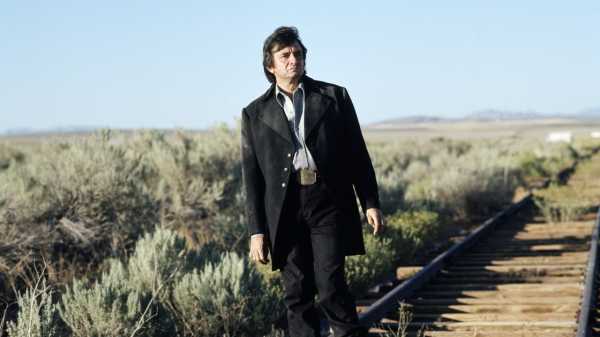
My toddler son has decided that what he cares most about in this world is trains, or, as he calls them, in exclamations that range from joyous to angry to plaintive, “choo-choos.” This choo-choo phase has changed my media diet, but I’ve tried to set some boundaries. No to Thomas the Tank Engine and its celebrations of authoritarianism. Yes to a nightly reading of the repetitive “The Little Engine That Could,” complete with sound effects, but only in a severely father-abridged form. Still, compromise being neither of our strong suits, we often find ourselves at loggerheads, and, because he’s allowed to scream and I’m not, that means we often end up watching videos of trains on YouTube.
It was one of those tiny wins of parenting when a recent search pulled up fifty-odd minutes of rather grainy footage of something called “Ridin’ the Rails,” a documentary from 1974 featuring Johnny Cash telling stories and singing songs about the glory days of the American railroad, complete with historical reënactments and period costumes. The movie opens with Cash, dressed in black, walking toward the camera along a train track, a guitar strapped to his back. I like it when Cash says, “You know, there’s nothing that stirs my imagination like the sound of a steam locomotive. That lonesome whistle cuttin’ through the night, and that column of black smoke and steam throwin’ shadows across the land.” My son likes it when Cash pulls the train’s horn. We both like it when he leans out the window, grinning like a kid, his coal-black mane blowing in the wind as the old locomotive comes up to speed.
Johnny Cash sang about trains from the start. His first record for Sam Phillips at Sun Records was “Hey Porter,” in 1955, a song Cash wrote about a train headed south. The song, performed with his backing band, the Tennessee Two, featured the boom-chicka-boom guitar sound, evoking a locomotive moving down the tracks, which would become one of his signatures. Cash’s train songs—those he wrote, and those by others that he performed—sound like trains, which seems to be my son’s principal genre requirement when he chirps for “choo-choo songs.” “Orange Blossom Special,” “Blue Train,” “Train of Love,” “Waiting for a Train,” all give off that splendid chugga-choo-choo, chuff and steam noise. We’ve yet to run out of material: Cash released three train-themed albums in the sixties alone—“Ride This Train,” “All Aboard the Blue Train,” and the compilation album “Story Songs of the Trains and Rivers.” Someday, my son may appreciate the master class in phraseology in “Let the Train Blow the Whistle,” from 1994—“Let her blow, let her blow, long and loud and hard and happy, let her blow”—but, for now, he digs the way the acoustic guitar ticks along. And, for a bit longer, we can both enjoy “Folsom Prison Blues” without my having to explain why it is “not O.K., no matter what Uncle Johnny says,” to shoot a man in Reno just to watch him die.
“Ridin’ the Rails,” which was created by Nicholas Webster and Diane Rivkin, and which aired in prime time on ABC in the fall of 1974, offers its own soundtrack of train songs. Cash sings “The Legend of John Henry’s Hammer” and “The Ballad of Casey Jones.” And he covers “Two-Ten, Six-Eighteen,” a mournful ballad about a soldier returning to a changed home front, and the Band’s “The Night They Drove Old Dixie Down,” with its reference to George Stoneman’s Union cavalry tearing up the tracks in the South.
In between songs, Cash dresses in costume for re-creations of notable moments of the American railroad: the first runs of a steam engine named Tom Thumb, in Baltimore, and the Best Friend of Charleston, in South Carolina; the laying of tracks in the rugged West (“It was a big job, and it needed men that could think a mile high and three thousand miles long”); and the joining of the First Transcontinental Railroad in Promontory Summit, Utah. Cash mixes in a bit of his own politics, as when he segues from talking about train robbers to robber barons. “The train bandits got nothing compared to the railway tycoons who built up great fortunes holding up the government and the people,” he says, before performing the gorgeous hobo’s lament “Crystal Chandeliers and Burgundy,” written by his son-in-law J. W. Routh. Yet despite a few notes of seriousness Cash mostly wears a goofy grin throughout, clearly tickled by the project. As a whole, the film is the kind of thing that some hip history teacher might show his eighth graders, but which just one kid in the class would think was cool.
The film ends with a tacked-on bit of optimism—“And now the trains are coming back!”—seemingly sponsored by Amtrak, the government’s stab at rekindling passenger railways, which launched three years earlier. But the overriding tone is a lament for times gone by. “When was it that the trains began to lose their glamour?” he asks. “Well, I guess it was when the diesels came along. Course, the diesels had to come, you know—they’re cheaper to run. But somehow they didn’t have that awesome fire-breathing presence that the old steam locomotives had. . . . ” By this point, my son’s attention begins to stray. Uncle Johnny has been doing an awful lot of talking and not much choo-chooing, and though my son gets a real kick out of his performance of Steve Goodman’s “City of New Orleans,” about the last gasps of the great perpendicular rail line from Chicago to the Gulf of Mexico, he seems to agree with Cash that the modern trains have lost their sheen and wonder. He prefers the old steam locomotives, too.
Sourse: newyorker.com






